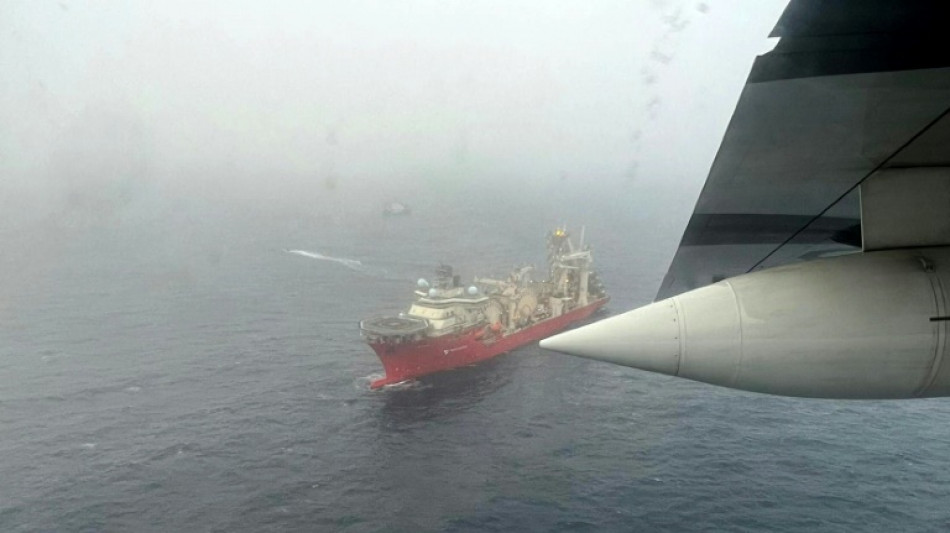

Rescuers 'target' underwater noises in hunt for lost Titanic sub
Rescue workers raced to beat a rapidly closing oxygen window Wednesday as they hunt for a missing submersible near the wreck of the Titanic, after noises detected by sonar raised hopes the five people onboard are still alive.
Extra ships, specialized salvage equipment and US Navy experts arrived in the vast search area in the North Atlantic, with the passengers of the small sub estimated to have less than 24 hours of oxygen left.
Rescuers, who have received help from around the world, were concentrating efforts on trying to figure out the source of "underwater noises" detected late Tuesday by a Canadian aircraft, US Coast Guard Rear Admiral John Mauger told CBS.
"It's something, it's a target, it's a focus for us to look at," he said.
"As long as there's an opportunity for survival, we will continue to work with this broad unified command to bring every resource to bear on the search," Mauger added.
All communication was lost with the 21-foot (6.5-meter) tourist craft less than two hours into its descent Sunday to see the remains of the Titanic, which sits more than two miles (nearly four kilometers) below the surface of the ocean.
The submersible, named Titan, was carrying British billionaire Hamish Harding and Pakistani tycoon Shahzada Dawood and his son Suleman, who also have British citizenship.
OceanGate Expeditions charges $250,000 for a seat on the sub.
- 'Mr Titanic' -
Also on board is also the company's CEO, Stockton Rush and a French submarine operator Paul-Henri Nargeolet, nicknamed "Mr Titanic" for his frequent dives at the site.
Ships and planes are scouring 7,600 square miles (around 20,000 square kilometers) of surface water -- larger than the US state of Connecticut -- for the vessel, which was attempting to dive about 400 miles off the coast of Newfoundland, Canada.
After the noises were detected, rescuers relocated two remotely operated vehicles (ROV) that search under the water and one surface vessel with sonar capability, Mauger said.
The ROV searches had so far not yielded results, but are continuing, Mauger added, saying that data from the Canadian aircraft had been shared with US Navy experts.
The US Coast Guard said in a tweet that three more search vessels, including one with side scanning sonar capabilities, arrived in the area Wednesday morning.
The Navy has sent a specialized winch system for lifting heavy objects from extreme depths, other equipment and personnel; and the Pentagon is deploying a third C-130 aircraft and three C-17s.
A deep-sea underwater robot sent by France's oceanographic institute is expected to arrive in the area early Wednesday afternoon.
- Fears of a leak -
Rescuers estimate that passengers now have less a day of oxygen left, based on the sub's capacity to hold up to 96 hours of emergency air.
The mission was expected to be the only manned trip to the Titanic this year due to bad weather, Harding wrote in an Instagram post before the journey.
The 58-year-old has three Guinness world records to his name and became a space tourist through Amazon founder Jeff Bezos's Blue Origin company a year ago.
Shahzada and Suleman Dawood hail from one of Pakistan's richest families, which runs Karachi-headquartered conglomerate Engro, with investments in energy, agriculture, petrochemicals and telecommunications.
The Titanic hit an iceberg and sank in 1912 during its maiden voyage from England to New York with 2,224 passengers and crew on board. More than 1,500 people died.
It was found in 1985 and remains a lure for nautical experts and underwater tourists.
The pressure at that depth as measured in atmospheres is 400 times what it is at sea level.
Mike Reiss, an American television writer who visited the Titanic wreck on the same sub last year, told the BBC the experience was disorientating and that he had to sign a waiver that "mentions death three different times on page one."
Alistair Greig, professor of marine engineering at University College London, has suggested two possible scenarios based on images of the Titan.
He said if it had an electrical or communications problem, it could have surfaced and remained floating, "waiting to be found" -- bearing in mind the vessel can reportedly be unlocked from the outside only.
"Another scenario is the pressure hull was compromised -- a leak," he said in a statement.
"Then the prognosis is not good."
In 2018, OceanGate Expeditions' former director of marine operations David Lochridge alleged in a lawsuit that he had been fired after raising concerns about the company's "experimental and untested design" of the craft.
F.Maldonado--LGdM




